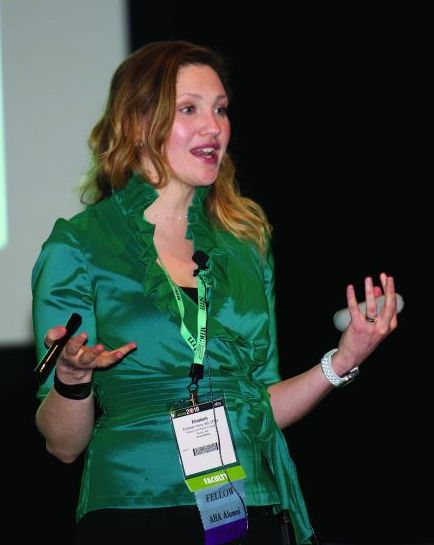User login
ORLANDO – If you think enough progress is being made to fix gender disparity in medical leadership, consider this observation made in an HM18 session on Tuesday by speaker Elizabeth Harry, MD, SFHM, assistant program director, internal medicine residency: director of wellness, Brigham and Women’s Hospital, Boston.*
“One might say, ‘Well, that’s okay, we’ll just let it even itself out. I mean, it’s getting better and we’re getting more women positions of leadership,’ ” she said. “But if we continue at the current rate that we are at, of women getting positions of leadership, we will get gender parity in leadership in 67 years – so the year 2085 ... I’m hoping that we as a group can say, ‘That’s a little too slow for our taste. We would like to accelerate this process a little bit.’ ”
The jarring number came near the start of the “Gender Disparities in Hospital Medicine: Where Do We Stand?” session, in which Dr. Harry explored the ways in which gender disparity manifests itself and coaxed ideas for improvement from the audience.
But that was just one of the jarring numbers. Even though women make up 78% of the health care workforce, only 14% of executive officers are women, Dr. Harry said.
And it’s not that large numbers of women joining the physician workforce is a relatively recent phenomenon. There is close to a 50/50 gender split in medical school applicants, students, and residents. But, after that, the parity falls away. Only 38% of medical school faculty members are women, only 21% of full professors are women, and only 16% of deans (Pediatr Res. 2015 Nov;78[5]:589-93).
“There’s definitely a leaky pipeline here,” Dr. Harry said.
She highlighted the ways in which gender disparity seems to be baked into medical education, research, and culture. One study found that women used professional titles 95% of the time when introducing men at internal medicine grand rounds, compared with 49% when men were introducing women (J Womens Health 2017 May;26[5]:413-9).
In hospital medicine, a 2015 study found that women make $14,000 a year less than men, and about $30,000 less in pediatrics. (J Hosp Med. 2015 Aug;10[8]:486-90).
Dr. Harry told the audience to think about the gender disparity problem in a structured way, similar to a design process, by defining the problem, thinking of ideas, developing prototypes to put those ideas into action, and testing them.
During this session, audience members made some suggestions to simplify some of life’s logistics: creating rooms in which physicians could nurse their babies, with a phone and a laptop to make use of the room more practical; building flexible schedules to allow for picking up children and running errands; and – Dr. Harry’s favorite – installing an Amazon locker at hospitals that would allow doctors to pick up packages and make returns.
One audience member asked why the tenor of the conversation seemed to involve an implicit acceptance that it was up to women to handle errands, wondering, “Why are we anchoring on to that?” Dr. Harry agreed that it is up to each household to decide how to divide those responsibilities, and that, personally, she and her husband divide them evenly.
“So what I want to encourage you to do is actually take one of these prototypes home and try it – and it’s not going to work the first time,” Dr. Harry said. “This is culture change, and culture change is really, really hard. That means it takes time and means you’ll have to knock on lots of doors to get to where you want to be eventually.”
Correction, 4/11/18: An earlier version of this article misstated Dr. Harry's position at Brigham and Women's.
ORLANDO – If you think enough progress is being made to fix gender disparity in medical leadership, consider this observation made in an HM18 session on Tuesday by speaker Elizabeth Harry, MD, SFHM, assistant program director, internal medicine residency: director of wellness, Brigham and Women’s Hospital, Boston.*
“One might say, ‘Well, that’s okay, we’ll just let it even itself out. I mean, it’s getting better and we’re getting more women positions of leadership,’ ” she said. “But if we continue at the current rate that we are at, of women getting positions of leadership, we will get gender parity in leadership in 67 years – so the year 2085 ... I’m hoping that we as a group can say, ‘That’s a little too slow for our taste. We would like to accelerate this process a little bit.’ ”
The jarring number came near the start of the “Gender Disparities in Hospital Medicine: Where Do We Stand?” session, in which Dr. Harry explored the ways in which gender disparity manifests itself and coaxed ideas for improvement from the audience.
But that was just one of the jarring numbers. Even though women make up 78% of the health care workforce, only 14% of executive officers are women, Dr. Harry said.
And it’s not that large numbers of women joining the physician workforce is a relatively recent phenomenon. There is close to a 50/50 gender split in medical school applicants, students, and residents. But, after that, the parity falls away. Only 38% of medical school faculty members are women, only 21% of full professors are women, and only 16% of deans (Pediatr Res. 2015 Nov;78[5]:589-93).
“There’s definitely a leaky pipeline here,” Dr. Harry said.
She highlighted the ways in which gender disparity seems to be baked into medical education, research, and culture. One study found that women used professional titles 95% of the time when introducing men at internal medicine grand rounds, compared with 49% when men were introducing women (J Womens Health 2017 May;26[5]:413-9).
In hospital medicine, a 2015 study found that women make $14,000 a year less than men, and about $30,000 less in pediatrics. (J Hosp Med. 2015 Aug;10[8]:486-90).
Dr. Harry told the audience to think about the gender disparity problem in a structured way, similar to a design process, by defining the problem, thinking of ideas, developing prototypes to put those ideas into action, and testing them.
During this session, audience members made some suggestions to simplify some of life’s logistics: creating rooms in which physicians could nurse their babies, with a phone and a laptop to make use of the room more practical; building flexible schedules to allow for picking up children and running errands; and – Dr. Harry’s favorite – installing an Amazon locker at hospitals that would allow doctors to pick up packages and make returns.
One audience member asked why the tenor of the conversation seemed to involve an implicit acceptance that it was up to women to handle errands, wondering, “Why are we anchoring on to that?” Dr. Harry agreed that it is up to each household to decide how to divide those responsibilities, and that, personally, she and her husband divide them evenly.
“So what I want to encourage you to do is actually take one of these prototypes home and try it – and it’s not going to work the first time,” Dr. Harry said. “This is culture change, and culture change is really, really hard. That means it takes time and means you’ll have to knock on lots of doors to get to where you want to be eventually.”
Correction, 4/11/18: An earlier version of this article misstated Dr. Harry's position at Brigham and Women's.
ORLANDO – If you think enough progress is being made to fix gender disparity in medical leadership, consider this observation made in an HM18 session on Tuesday by speaker Elizabeth Harry, MD, SFHM, assistant program director, internal medicine residency: director of wellness, Brigham and Women’s Hospital, Boston.*
“One might say, ‘Well, that’s okay, we’ll just let it even itself out. I mean, it’s getting better and we’re getting more women positions of leadership,’ ” she said. “But if we continue at the current rate that we are at, of women getting positions of leadership, we will get gender parity in leadership in 67 years – so the year 2085 ... I’m hoping that we as a group can say, ‘That’s a little too slow for our taste. We would like to accelerate this process a little bit.’ ”
The jarring number came near the start of the “Gender Disparities in Hospital Medicine: Where Do We Stand?” session, in which Dr. Harry explored the ways in which gender disparity manifests itself and coaxed ideas for improvement from the audience.
But that was just one of the jarring numbers. Even though women make up 78% of the health care workforce, only 14% of executive officers are women, Dr. Harry said.
And it’s not that large numbers of women joining the physician workforce is a relatively recent phenomenon. There is close to a 50/50 gender split in medical school applicants, students, and residents. But, after that, the parity falls away. Only 38% of medical school faculty members are women, only 21% of full professors are women, and only 16% of deans (Pediatr Res. 2015 Nov;78[5]:589-93).
“There’s definitely a leaky pipeline here,” Dr. Harry said.
She highlighted the ways in which gender disparity seems to be baked into medical education, research, and culture. One study found that women used professional titles 95% of the time when introducing men at internal medicine grand rounds, compared with 49% when men were introducing women (J Womens Health 2017 May;26[5]:413-9).
In hospital medicine, a 2015 study found that women make $14,000 a year less than men, and about $30,000 less in pediatrics. (J Hosp Med. 2015 Aug;10[8]:486-90).
Dr. Harry told the audience to think about the gender disparity problem in a structured way, similar to a design process, by defining the problem, thinking of ideas, developing prototypes to put those ideas into action, and testing them.
During this session, audience members made some suggestions to simplify some of life’s logistics: creating rooms in which physicians could nurse their babies, with a phone and a laptop to make use of the room more practical; building flexible schedules to allow for picking up children and running errands; and – Dr. Harry’s favorite – installing an Amazon locker at hospitals that would allow doctors to pick up packages and make returns.
One audience member asked why the tenor of the conversation seemed to involve an implicit acceptance that it was up to women to handle errands, wondering, “Why are we anchoring on to that?” Dr. Harry agreed that it is up to each household to decide how to divide those responsibilities, and that, personally, she and her husband divide them evenly.
“So what I want to encourage you to do is actually take one of these prototypes home and try it – and it’s not going to work the first time,” Dr. Harry said. “This is culture change, and culture change is really, really hard. That means it takes time and means you’ll have to knock on lots of doors to get to where you want to be eventually.”
Correction, 4/11/18: An earlier version of this article misstated Dr. Harry's position at Brigham and Women's.
REPORTING FROM HM18

